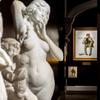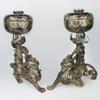Melodious Mechanical Marvels: Antique Music Boxes
- January 20, 2014 16:33
“Music gives a soul to the universe, wings to the mind, flight to the imagination and life to everything.” ― Plato
Music has the ability to uplift, convey strong emotions and bring people from all walks of life closer together. The desire for reproducing and sharing this powerful art form is as old as music itself. Long before MP3s and CDs made their impact on the world, craftsmen sought to make music not only portable, but also accessible to a broader audience. It wasn’t until the invention of the music box did that idea become a reality.
The first historical record of a mechanical music device dates to 9th century Iraq with the creation of a water-powered organ that played cylinders outfitted with tiny pins that corresponded to particular notes on the organ. It is this very cylinder design that was used in music boxes through the 19th century. The next innovations were pioneered by clock and watchmakers in the 18th century, who designed stunning snuff boxes, known as carillons à musique, with diminutive cylinder mechanisms that plucked the teeth of a metal comb to play a delightful tune while holding one’s favorite tobacco blend. This beautiful Swiss Musical Snuff Box is a fine example, demonstrating outstanding mechanical ingenuity with superior craftsmanship.
Cabinet-makers began making their contributions in the 19th century with the creation of elaborate table-top versions of the music box. Some, like this Swiss Ouverture Cylinder Music Box by B.A. Bremond featured superior-quality mechanisms encased in handsome wood boxes adorned with intricate inlays. More elaborate examples, such as the Sublime Harmonie Music Box not only came with their own beautifully crafted tables, but more complex mechanisms that incorporated bells, drums and castanets to create depth and richness in their sound.
The invention of the phonograph by Thomas Eddison and World War I had a dramatic impact on the music box industry, with many companies either going out of business, or converting their businesses to making watches and other mechanical devices. Other companies, like Arburo of Belgium, made innovations well into the mid-20th century. This remarkable Arburo Orchestrion Organ by Bursens and Roels uses a paper roll and a bellows to play stand-alone instruments, including drums, triangle and an accordion, which are integrated in the mechanism. Such incredible mechanical instruments had the ability to produce music once only possible by a full band, and were a common feature in dancehalls and cafés throughout Belgium and the Netherlands.
From grand mechanisms that replaced an entire orchestra to miniature instruments that fit in your pocket, the world of music boxes is as varied as the collectors who treasure them.
To learn more about music boxes and to see M.S. Rau Antiques’ selection of these mechanical wonders, click here.
About M.S. Rau Antiques:
M.S. Rau Antiques has spent over 100 years earning the trust of discerning collectors world-wide. Located in the heart of New Orleans’ historic French Quarter, our peerless gallery showcases some of the world’s most extensive and stunning works of important fine art by artists such as Monet and van Gogh, rare 18th-and 19th-century antiques and breathtaking jewelry, including rare colored diamonds.


















100x100_c.jpg)


